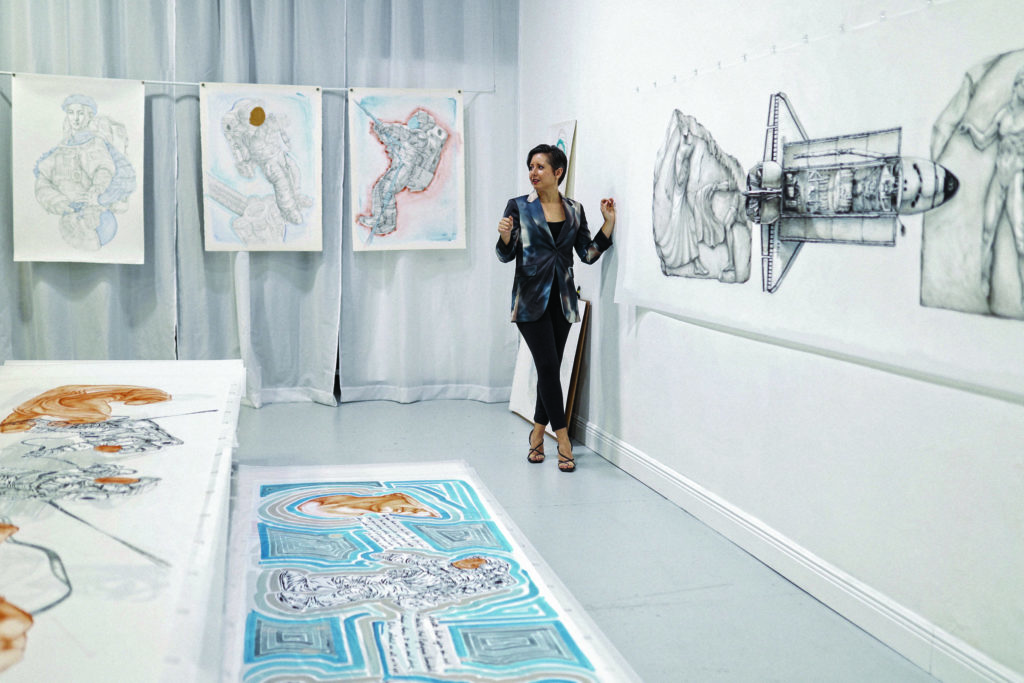One day in October 2019, Naples’ artist Lauren Amalia Redding was scrolling through Instagram when she stumbled across NASA’s livestream of the first all-female spacewalk outside of the International Space Station. She was gripped. “The pure meritocracy of that moment,” she reflects. “Those spacewalks are life and death situations; the astronauts chosen had nothing to do with virtue signaling. The two women were chosen because they were the best people for the job.” She thought about how far things had come from when her mother, a Hispanic immigrant, was told she’d never go to college.
Since she graduated from the New York Academy of Art in 2011, Redding has built an impressive body of work around her extraordinary skills as a draftswoman. Figure drawing and portraiture are at the core of what she does. While she is adept in oils, graphite and drypoint etching, she is best known for her drawings in silverpoint, a centuries-old technique used by Dürer and da Vinci in which a silver nib is applied to a gesso ground, producing a delicate, precise but ethereal effect.
Redding was in her second year of graduate school when someone suggested silverpoint to her after seeing how neat her apartment was. “I was really insulted,” she says with a laugh. But she soon began to appreciate the exacting medium’s unique characteristics. “I’m a geek,” she says. “I love art history. I love silverpoint’s relationship to history. And I love the fastidiousness of it.” In a time when it’s all too easy to be distracted scrolling through screens, she appreciates how silverpoint anchors her to extreme levels of self-discipline and focus.
Perhaps, it’s ironic that Redding’s latest series began on Instagram, but there’s no trace of the digital world’s superficiality in her work, which is on display at the Switzer Gallery at Pensacola State College through March 11 as part of her solo exhibit, Interstellar Insulation.
The exhibit signals a sea change in Redding’s work. For most of the past decade, she was absorbed by tender portraits of her mother’s Cuban family. Her grandmother worked as a housekeeper in Naples for more than 40 years, and Redding grew up among an extended community of immigrants. When she lived in New York, the project presented the artist with a way to anchor herself to her family. In 2018, Redding and her husband, sculptor Brett F. Harvey, decided to leave New York and make a life in Naples. Together, they set up H&R Studio in East Naples, where they produce their work and host workshops, events and private lessons. “All of a sudden, I had a lot more physical and geographic proximity to the people in the exile community that I was depicting,” Redding says. “I started to feel less engaged with that particular subject—probably because they were always calling me wanting to know if I was hungry.”
It was only after some months of drawing astronauts that she realized immigrants and astronauts are not so different. “Both step into this unknown frontier and take this tremendous risk without knowing what’s in front of them,” she says. “You can have all the preparation in the world behind you, but ultimately, you’re a stranger in a strange land.”
As she sketched the astronauts, Redding confronted a series of existential questions: What does the spacesuit stand for? What’s inside it? What do these things encapsulate? The more she drew, the more layered meaning she delved. “The spacesuit is a protective device, like an armor, that allows you to go into hostile environments and complete your mission,” she says. The cords on the suits, Redding reflects, function as umbilical cords, tying you back to your home base. “There’s an awful lot of meaning there,” she says.
The focus of Interstellar Insulation is a suite of panoramic drawings in ink, charcoal, graphite, pastel and acrylic on Dura-Lar (a polyester film similar to acetate), most around 12 feet long. At first, she drew herself inside the astronaut suits, a decision that arose, in part, because she didn’t have much access to live models during the pandemic. She soon moved beyond autobiographical projection to reflect on the long arc of history: the imminent obsolescence of the technology that makes space travel possible and the enduring importance of Classical art, literature and philosophy. She thought about the Roman god Janus, a two-faced being who looked both to the future and the past. “Each astronaut is a presentation of Janus,” she says.
She also created mixed-media drawings in which the silverpoint spacesuits are overlaid—and underlaid—with copies of Old Masters’ pieces in silverpoint and acrylic. In one drawing, the figure within is a replica of a 16th-century portrait of Sir Thomas Moore by Hans Holbein.
Redding’s project comes at a time when space travel is beginning to seem less like a superhuman endeavor, and more like a commercial service, much like plane travel was in the 1940s. In Bookends, one of the 12-foot panels, Redding positions a spaceship between a two halves of a fragmented Parthenon frieze. The ship’s nose points to the horse, reflecting the “endlessly circular conversation between past and present,” she says, adding, “Once our transport was limited by the animals we could ride, now we can fling ourselves into outer space.”
In the midst of a bruising two-year pandemic, we are all, like Redding, looking toward the future and reflecting on the past. Redding’s work, and the questions she poses, could not be more apt or timely for our current uncertain moment.





